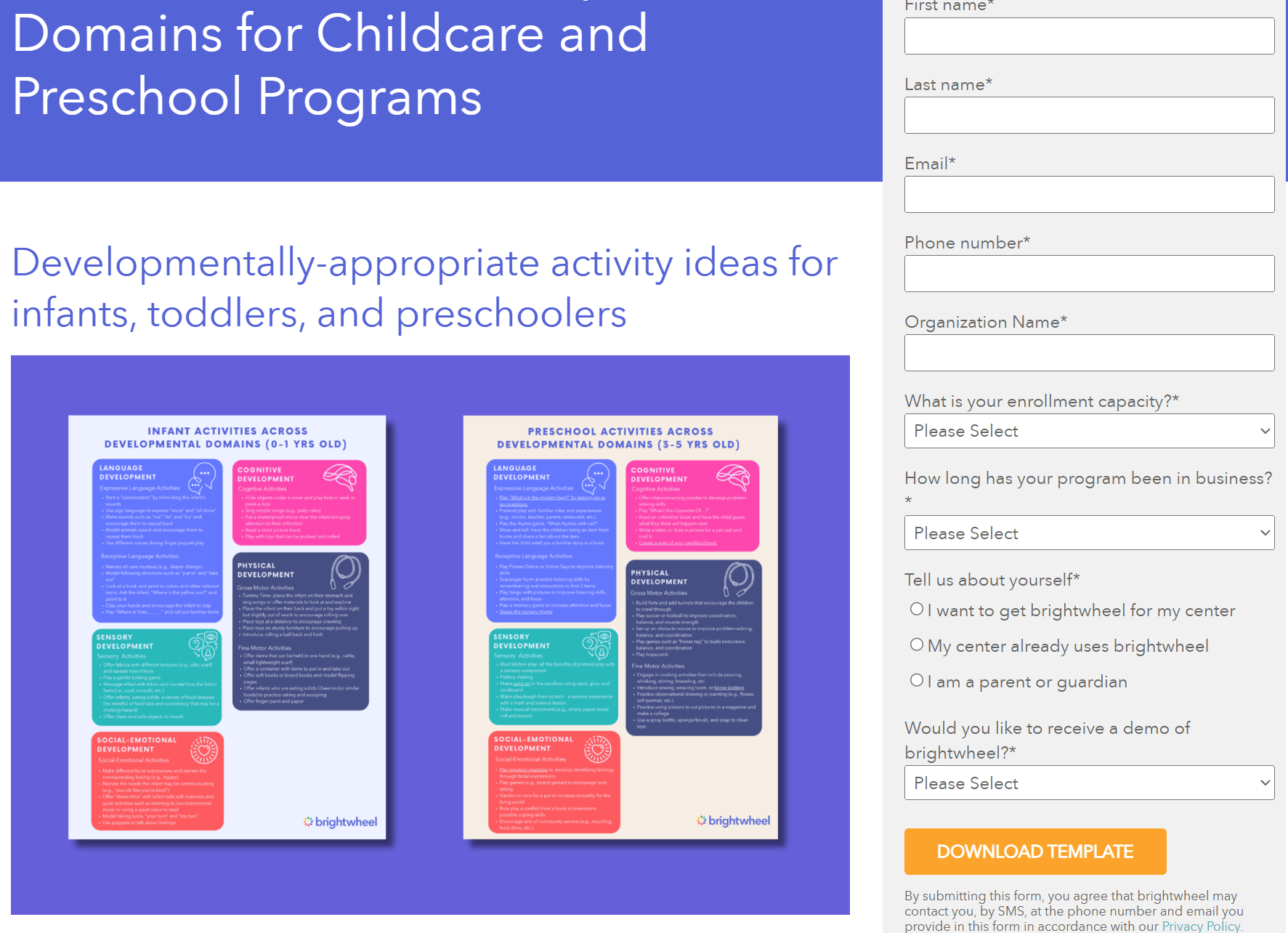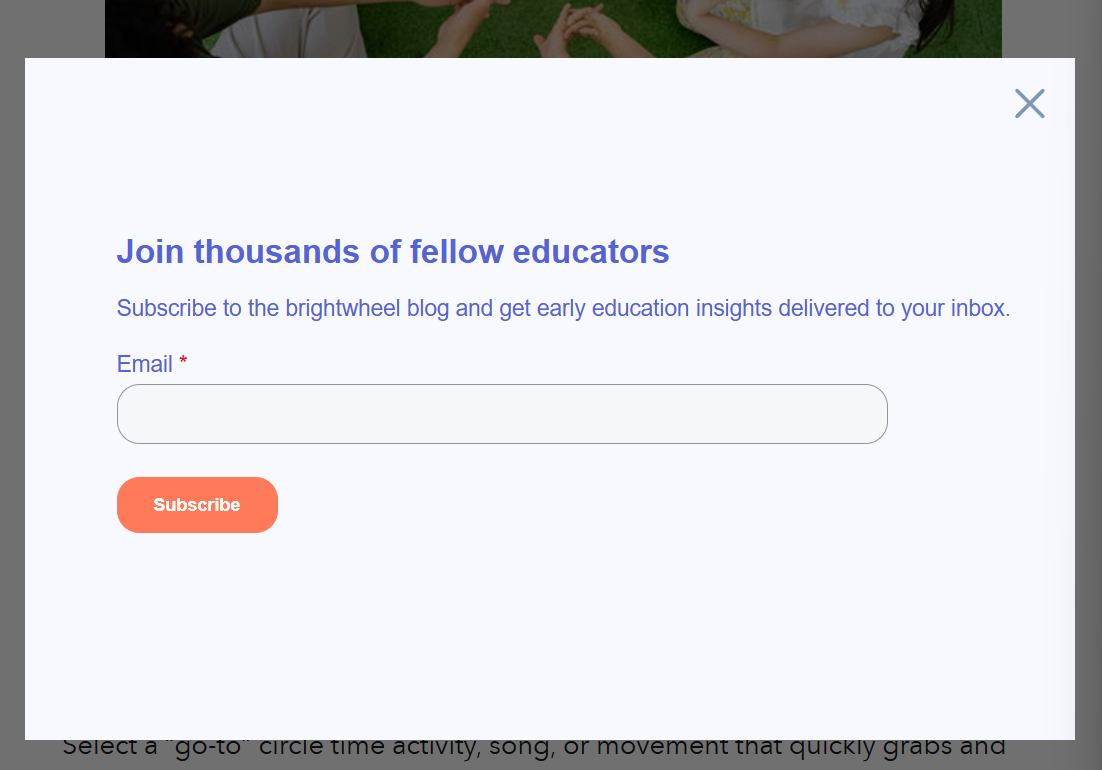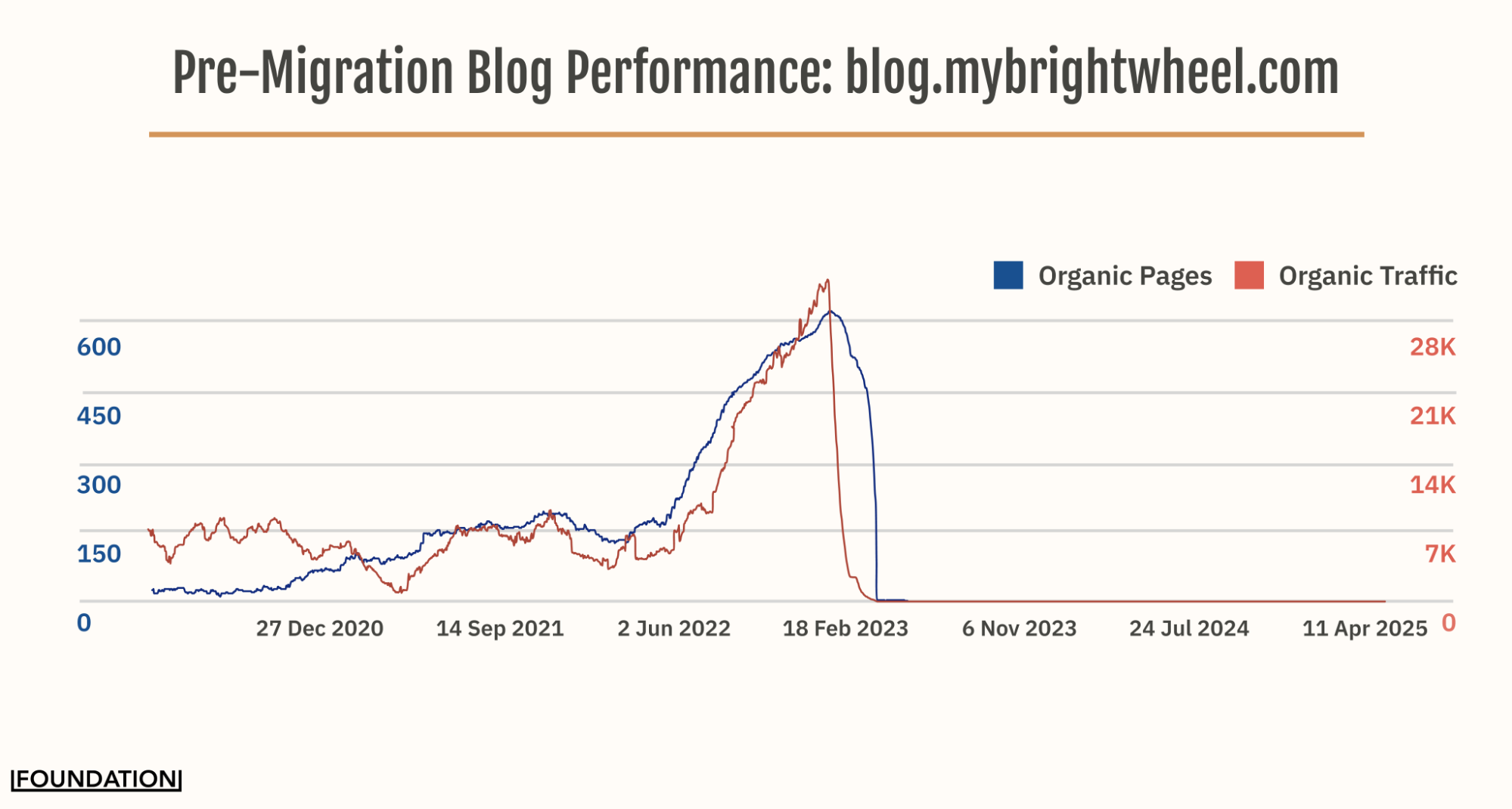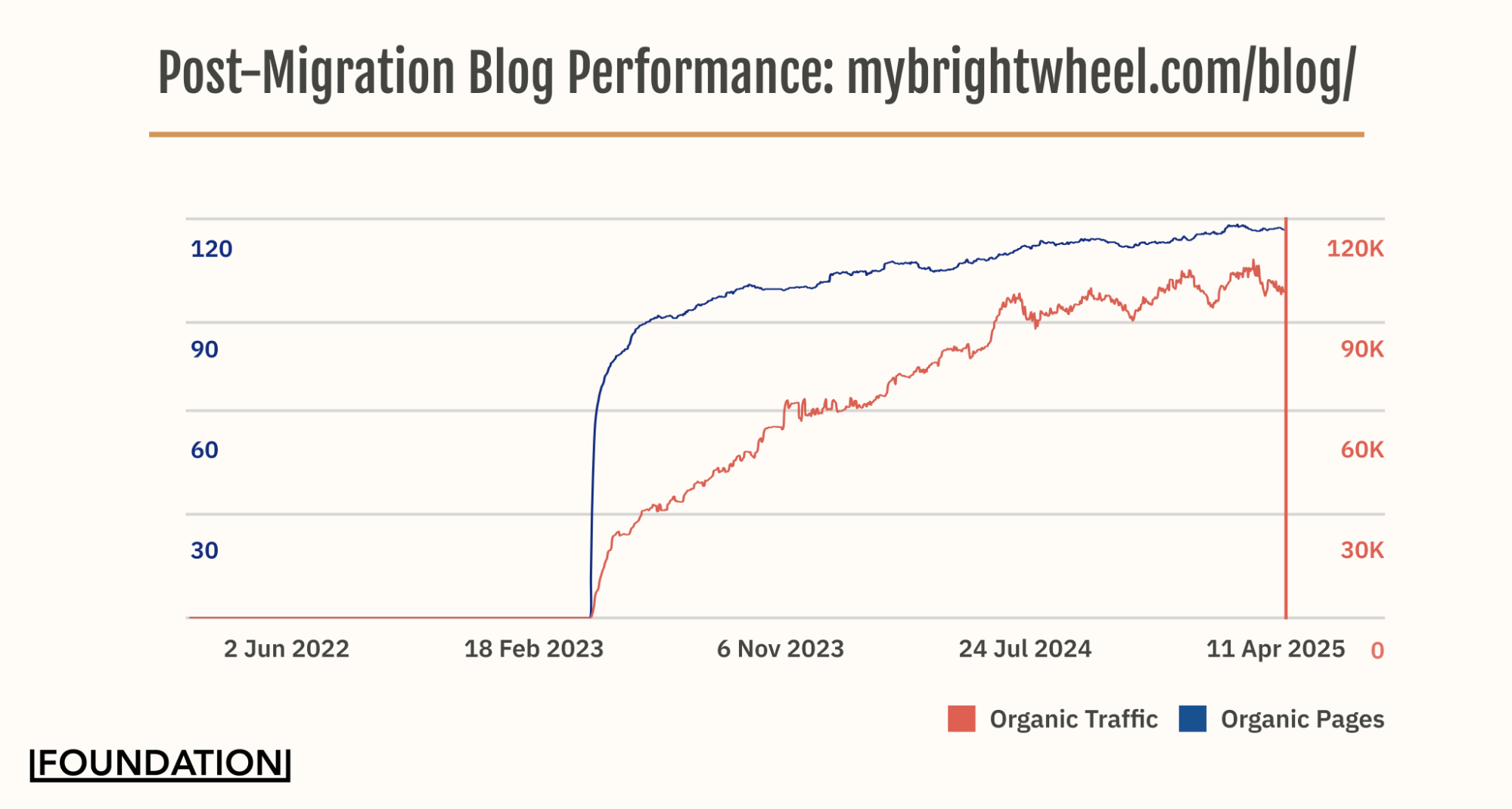Article's Content
At Foundation, we follow a cardinal rule for content:
If it doesn’t do one of the 4 E’s, educate, engage, entertain, or empower, it’s probably not worth creating.
People rarely take action unless you connect with them on an emotional level or help solve an immediate problem. And that’s exactly what the 4 E’s aim to do.
Consider brightwheel: a leading childcare management platform that uses content to educate and empower its audience. The platform helps teachers, administrators, and parents navigate the many moving parts of early childhood education.
You may recognize brightwheel from their high-profile launch on Shark Tank many moons ago, where they secured an investment from Mark Cuban. That splashy launch certainly gave brightwheel a brand boost, but truly sustainable growth requires more than just TV fame.
In this post, we’ll look at how brightwheel’s approach to educational content helps them:
- Achieve over 100,000 organic visits each month across 600+ pieces of content
- Prioritize listicle-style posts that educate and empower early childhood educators
- Generate leads with gated educational assets that funnel visitors into detailed lead-capture forms
Stick around until the end because we also review how a key structural change to brightwheel’s website kickstarted a massive uptick in organic performance.
Let’s dive in.
Understanding brightwheel’s Connection to Early Childhood Educators and Administrators
Education and empowerment are central to brightwheel’s mission from both a product and marketing standpoint. Nowhere is that more evident than in their 600+ page blog.
brightwheel’s blog is built for early childhood education (ECE) professionals, especially decision-makers like center directors, administrators, and childcare business owners. These are the people who typically decide whether to purchase and implement brightwheel, while teachers, staff, and parents are the ones using the platform’s key features day-to-day. To serve both groups, the blog is organized into focused categories:
- Running a Business
- Child Development
- Staff Development
- Curriculum
- Financial Health
This category structure mirrors the core priorities of their target audience, which includes early learning administrators and ECEs juggling administrative demands, classroom quality, and financial sustainability. Each category delivers insights and actionable advice that align with brightwheel’s product features: streamlining ECE operations, enhancing the curriculum, and simplifying financial management.
This educational content positions brightwheel as a thought leader and trusted resource for ECE professionals and administrators, offering a supportive entry point into the platform without feeling overly salesy.
Let’s take a closer look at how they do it.
The Power of Practical Content: Educate and Empower
brightwheel has made steady investments in their blog since launching in the mid-2010s. Today, with more than 600 pages, it’s become a powerful SEO moat that delivers strong organic search results:
- 100,000+ monthly visits at a value of $75,000
- A top 3 SERP position for 6,000+ keywords
- Driving 43% of all brightwheel’s organic traffic
These results are no accident.
brightwheel’s content strategy is designed to inform and support their audience. That’s why they position themselves as both a brainstorming buddy and a motivator for the entire ECE community. Their blog’s mission statement drives this point home:
“Ideas and inspiration to help you run an amazing early education center.”

The blog’s focus on ideas and inspiration makes its purpose clear, and connects with 2 of the 4 Es of content: educate and empower. Or in brightwheel’s case, the 2 Is.
While teachers and caregivers don’t make the final purchase decision, two of brightwheel’s blog categories, child development and curriculum, are created specifically for them.
It’s a smart move, similar to what product-led brands like MongoDB and Grafana Labs do by building resources for developers long before decision-makers enter the picture. The goal is the same: earn trust with end users early because they’re the ones who influence adoption and advocate for the product within the company.
Sparking Ideas and Inspiration with Listicles Content
brightwheel knows that teachers use their product daily, so they balance the administrative content with resources specifically for educators.
You can see the value of this end-user focus by looking at brightwheel’s top 10 blog posts by monthly traffic:

A closer look at top-performing pages reveals that most—6 out of 10—are listicles with educational and empowerment angles.
Listicles sometimes get a bad rap in the content space, but they’re often a go-to format for busy professionals like educators, who are always time-crunched and hunting for fresh ideas.
If you know any teachers you’ve likely seen how much time they spend looking for new ideas. That might mean innovative lesson plans, creative icebreakers, or ways to improve their classroom management.
And that’s why listicles work so well for ECEs.
They make it easy to share a lot of ideas quickly, which is exactly what time-strapped educators need. So it’s no surprise that the majority of brightwheel’s 10 posts are idea-packed lists that cover everything from Teacher Appreciation Week Celebrations to preschool science activities to daycare floor plan layouts.
“Ideas” are Central to brightwheel’s Strategy — Literally
brightwheel makes ideation a core part of their content strategy. They highlight “ideas” and “inspiration” in their blog mission and use them to guide topic planning.
According to Ahrefs, about 140 blog pages rank for long tail keywords that include the word “ideas,” and 74 of those hold a top 10 position in search results. Here are some of the most impactful topics they’ve targeted with listicle-style content:
- Teacher appreciation ideas — 4th SERP position
- Daycare room setup ideas — 1st SERP position
- Daycare name ideas — 1st SERP position
- Staff appreciation ideas — 6th SERP position
- Preschool graduation ideas — 1st SERP position
- Daycare menu ideas — 1st SERP position
- Preschool craft ideas — 2nd SERP position
- Circle time ideas — 1st SERP position
Targeting idea-focused keywords helps brightwheel reach educators and administrators looking for support with day-to-day challenges. Offering practical solutions and inspiration builds trust and positions the brand as a go-to resource for ECE professionals.
But they don’t just stop there. The brightwheel team incentivizes blog visitors to move further down the funnel by opting-in to access even more helpful information and resources.
Using Every Blog Visit as a Lead Capture Opportunity
The listicle visits from teachers, caregivers, and administrators are a golden opportunity for brightwheel to qualify leads. After all, these visitors arrive specifically because they want helpful content, and brightwheel delivers.
Since many educators are on-the-go, and not sitting at a desk with time to rummage through folders or files, brightwheel includes multiple CTAs for downloadable content like checklists, printables, and activity guides. A sticky sidebar CTA, similar to what Personia uses, keeps those resource opt-ins visible and easily accessible for readers.

If a reader wants to access these free resources, they’re asked to provide basic contact details like name, email, phone number, and organization. To better identify marketing qualified leads, brightwheel also collects a few additional data points that signal purchase intent and fit.
That includes information like:
- Enrollment capacity
- Program longevity
- Whether they currently use brightwheel, want to use it, or are a parent
- Whether they’d like a demo

That’s a lot of data—well beyond the usual name/email pairing. Still, it’s valuable insights for brightwheel’s sales funnel. Of course, the more fields you add to a form, the more friction you introduce, and that can lead to lower conversion rates. But brightwheel has clearly decided the tradeoff is worth it to collect higher-quality leads.
Some of that extra information, like enrollment capacity and how long a center has been in business, gives the marketing team important context. It helps them gauge where a lead is in the buying process and decide whether to nurture them further or forward them to sales.

Even on blog pages with a dedicated lead magnet, brightwheel prompts users to opt-in to their newsletter with a mid-scroll pop-up. This moves even casual readers from being one-off visitors to potential leads in brightwheel’s funnel.
Bonus: The Benefits of brightwheel’s Blog Restructure
Content strategy is key to organic search success, but it’s also important to think about your website’s structure.
brightwheel’s blog wasn’t always under the main mybrightwheel.com domain. It used to live at blog.mybrightwheel.com, a subdomain separated from the rest of the site. Then in May 2023, brightwheel migrated its entire blog to a subfolder (mybrightwheel.com/blog/), a move that sparked a steep increase in organic traffic over the next few years.
Here’s what happened:
For years, the blog.mybrightwheel.com subdomain netted between 5,000 and 10,000 organic monthly visits. Then brightwheel turned on their content engine. From October 2022 to May 2023, brightwheel’s content team drastically increased blog production, adding over 200 new pages to the blog subdomain.
Just before the migration, brightwheel’s blog contained about 400 pages, netting a new high in monthly traffic at around 26,000 visits.

Over the next month, brightwheel moved these 400 blogs to a new blog subfolder under the mybrightwheel.com root domain, with monthly traffic quickly returning to similar pre-migration levels.
In the two years since the migration, brightwheel has added another 180+ pages to this new blog subfolder, skyrocketing traffic up to 100,000 monthly visits—a 4x increase.

The blog.mybrightwheel.com subdomain showed steady signs of growth before the restructure, so it’s unknown what the ultimate results would’ve been had they stuck with the original plan. Google has historically stated that, while subdomains are treated as distinct sites from a root domain, they don’t have a preference between subdomains vs subdirectories.
But many SEOs disagree as a number have witnessed a change in SERP ranking and organic traffic when moving from one to the other. It’s typically the subfolder that sees a bigger increase in traffic. Here are a few reasons why:
- Consolidating domain authority: All content contributes to and benefits from the main domain’s authority, creating a positive feedback loop where backlinks strengthen the entire domain helping new content rank.
- Distributing link equity: Subfolders more efficiently distribute link equity through internal linking, external backlinks, and a consolidated link profile creating stronger overall ranking potential.
- Increasing keyword density: Content in subfolders increases keyword density for your main domain, giving your site a higher likelihood of appearing in search results for specific keywords without increasing keyword cannibalization.
The bottom line: While we can’t definitively say brightwheel’s move from subdomain to subfolder is the cause of their traffic explosion, it tracks with the conventional wisdom among SEO experts. And it’s hard to argue with brightwheel’s results.
Take Your Educational Content Strategy to the Next Level
The success of brightwheel’s blog is a perfect example of why it’s important to educate and empower all of your audience segments. If they simply went after the top-level administrators making purchase decisions, they would be missing out on a sizable chunk of traffic that could end up becoming brightwheel champions.
Here are the key takeaways from brightwheel’s content strategy:
- Identify topic categories for your blog that mirror your audience’s core priorities and challenges
- Focus on practical, actionable content that serves both decision-makers and, if you can, end-users
- Maximize lead capture opportunities with high-value downloadables that justify asking for detailed prospect information
- Consider the technical structure of your site and identify the changes that can multiply your organic results
Not sure if this content strategy works for your brand? Learn why Foundation is the top digital marketing agency for B2B brands — whether you’re in Tech, Higher Ed or anything in between.







